Comcast Bundle
How Does Comcast Stay Ahead in the Media and Tech Race?
Comcast, a titan in the media and technology landscape, has undergone a remarkable transformation. From its humble beginnings as a cable provider, the company has evolved into a global powerhouse, navigating the complexities of cord-cutting and streaming. Understanding Comcast's Comcast SWOT Analysis is key to grasping its strategic moves.
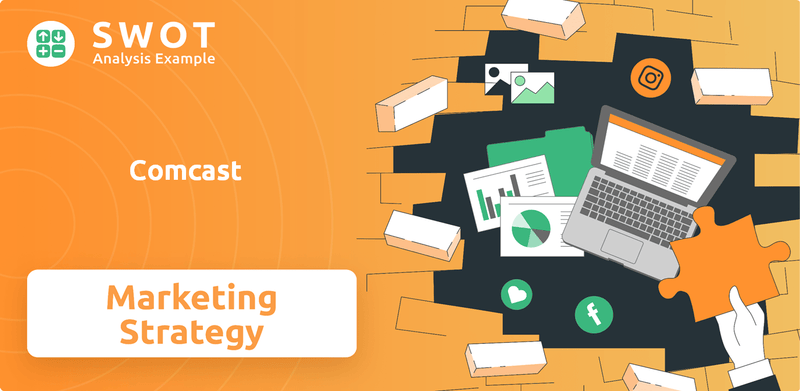
This article delves into the core of Comcast's success, exploring its dynamic Comcast sales strategy and Comcast marketing strategy. We'll dissect how Comcast leverages its Comcast strategy to maintain and grow its Comcast market share in a competitive environment, examining its Comcast business model and diverse Comcast revenue streams. Expect a deep dive into Comcast's digital marketing strategy, customer acquisition, and retention tactics, alongside analysis of its advertising campaigns and sales performance.
How Does Comcast Reach Its Customers?
The sales channels employed by the company are a critical component of its overall sales and marketing strategy, designed to reach a broad customer base and drive revenue growth. This approach is a blend of digital and traditional methods, ensuring comprehensive market coverage. The company's strategy focuses on providing multiple avenues for customer acquisition and engagement, adapting to evolving consumer preferences and technological advancements.
The company's sales strategy leverages both online and offline channels to maximize customer reach and acquisition. The online channels include a comprehensive e-commerce platform, complemented by a mobile app. Offline channels include physical retail locations and direct sales teams. This multifaceted approach supports the company's goal of maintaining and growing its market share.
The company’s sales and marketing tactics are geared towards enhancing customer experience and driving sales across various platforms. This omnichannel strategy allows the company to cater to diverse customer preferences, ensuring accessibility and convenience. The integration of these channels is crucial for maintaining a competitive edge in the rapidly evolving telecommunications market.
The company's online sales channels are primarily centered around its e-commerce platform, Xfinity.com, and the Xfinity My Account app. These platforms enable customers to explore, customize, and subscribe to various services. The digital channels have seen increased investment in user experience and personalization to match the convenience of direct-to-consumer models, reflecting the growing trend of digital adoption.
Offline sales channels include a network of physical retail locations, branded as Xfinity Stores, which serve as crucial touchpoints for sales and customer service. Direct sales teams also play a vital role, targeting residential and commercial customers. These channels remain integral, especially for complex service packages or customers preferring in-person assistance.
The company engages in key partnerships and exclusive distribution deals, particularly for its Xfinity Mobile service, which operates as an MVNO on Verizon’s network. This allows the company to bundle mobile services with its core offerings, enhancing its competitive position. The company's strategic partnerships and distribution agreements are vital for expanding its market reach and service offerings.
Omnichannel integration ensures a seamless customer experience across all touchpoints, contributing to sustained growth and market share. This integration is crucial for providing a consistent and user-friendly experience, regardless of the channel. The company's ability to integrate its sales channels is a key factor in its success.
The company’s sales and marketing strategy emphasizes digital transformation and customer-centric approaches. This includes investing in e-commerce, mobile apps, and personalized customer experiences. The company continually refines its sales processes to optimize efficiency and customer satisfaction. For a deeper understanding of the target market, consider reading about the Target Market of Comcast.
- Digital Marketing: Implementing targeted advertising campaigns across various online platforms.
- Customer Relationship Management (CRM): Utilizing CRM systems to manage customer interactions and personalize offers.
- Product Launch Strategies: Employing strategic product launches to introduce new services and features.
- Customer Retention: Focusing on customer retention through loyalty programs and proactive customer service.
Comcast SWOT Analysis
- Complete SWOT Breakdown
- Fully Customizable
- Editable in Excel & Word
- Professional Formatting
- Investor-Ready Format
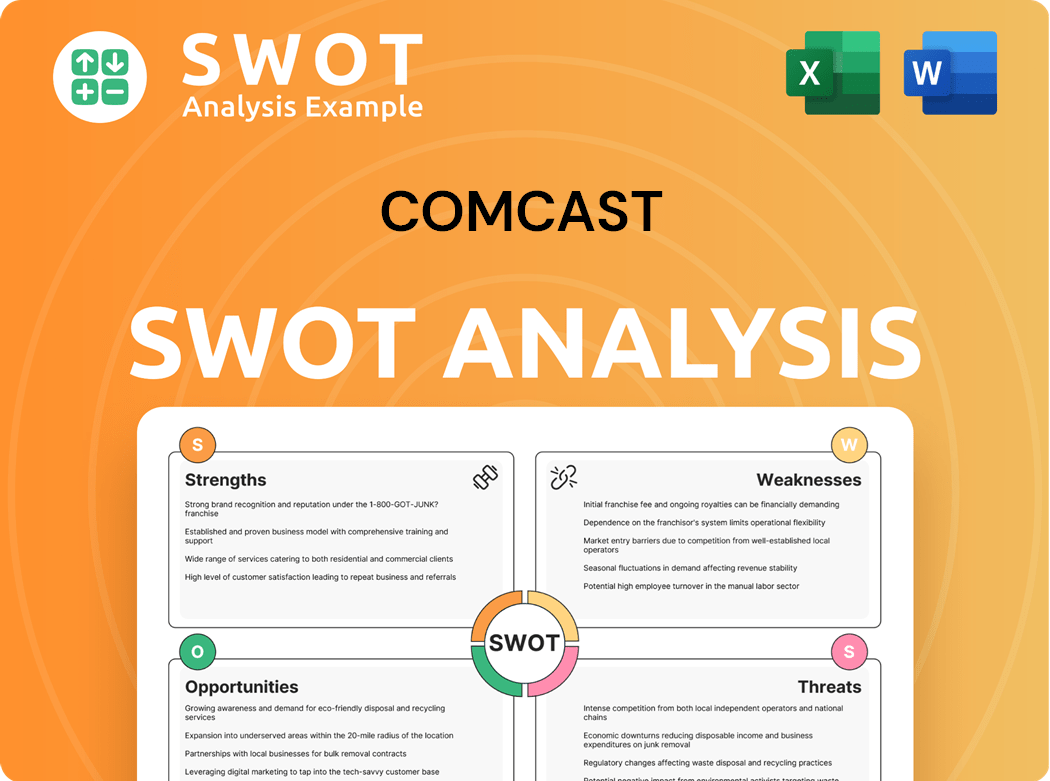
What Marketing Tactics Does Comcast Use?
Comcast's marketing strategy is multifaceted, employing a blend of digital and traditional tactics to reach a broad customer base. The company focuses on building brand awareness, generating leads, and driving sales across its various service offerings, including broadband, entertainment, and smart home solutions. Their approach is data-driven, utilizing sophisticated analytics to personalize marketing messages and improve customer engagement.
The Comcast sales strategy relies heavily on digital channels, content marketing, and search engine optimization (SEO) to enhance online visibility. Paid advertising campaigns on search engines and social media platforms are integral, alongside email marketing for nurturing leads and promoting offers. Influencer partnerships and social media engagement further amplify their reach, especially among younger demographics.
Traditional media, such as TV, radio, and print, still play a significant role in Comcast's marketing strategy, particularly for large-scale campaigns. They continuously refine their data analytics capabilities, using AI and machine learning to predict customer churn and identify upselling opportunities. This maximizes the efficiency and effectiveness of their marketing efforts, ensuring they stay competitive in the rapidly evolving media landscape.
Digital marketing is a cornerstone of the Comcast sales and marketing tactics. This includes content marketing, SEO, and paid advertising across search engines and social media.
Despite the digital shift, traditional media like TV, radio, and print remain important for broad reach. These channels are particularly useful for major product launches and seasonal promotions.
Comcast's strategy increasingly uses data analytics to segment customers and personalize marketing messages. This targeted approach aims to improve conversion rates and enhance customer satisfaction.
Influencer partnerships are utilized, especially in tech and entertainment, to build credibility and reach younger demographics. This strategy helps in expanding their customer base.
Social media platforms like Facebook, X (formerly Twitter), and Instagram are used for brand engagement, customer service, and targeted advertising. This enhances customer interaction.
In 2024, Comcast continued to leverage AI and machine learning to predict customer churn and identify upselling opportunities. This increases the efficiency of marketing efforts.
Comcast employs a variety of tactics to maintain its market position and attract new customers. These tactics are designed to be adaptable and responsive to market changes, ensuring effective customer engagement and sales growth.
- Content Marketing: Creating informative content to engage customers and build brand awareness around broadband, entertainment, and smart home solutions.
- SEO and Paid Advertising: Utilizing SEO to improve search visibility and running extensive paid advertising campaigns on search engines and social media.
- Email Marketing: Nurturing leads and communicating promotional offers through targeted email campaigns.
- Influencer Partnerships: Collaborating with influencers to reach younger demographics and build credibility.
- Social Media Engagement: Using platforms like Facebook, X (formerly Twitter), and Instagram for brand engagement, customer service, and targeted advertising.
- Traditional Media: Allocating resources to TV, radio, and print advertising for broad reach, especially for new product launches.
- Data Analytics: Employing sophisticated analytics tools to segment customers, personalize marketing messages, and improve conversion rates.
- AI and Machine Learning: Leveraging AI to predict customer churn and identify upselling opportunities, enhancing marketing efficiency.
For more insights into the financial aspects of the company, including its performance and strategic direction, you can explore the information available for Owners & Shareholders of Comcast.
Comcast PESTLE Analysis
- Covers All 6 PESTLE Categories
- No Research Needed – Save Hours of Work
- Built by Experts, Trusted by Consultants
- Instant Download, Ready to Use
- 100% Editable, Fully Customizable
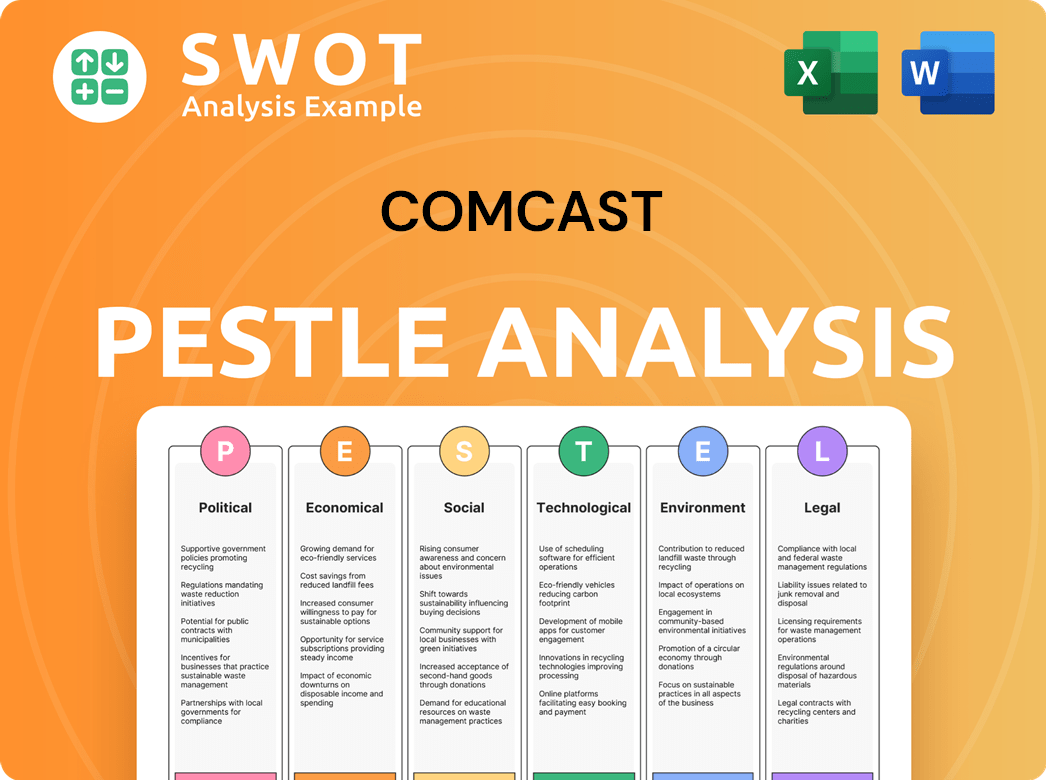
How Is Comcast Positioned in the Market?
Comcast's brand positioning centers on delivering reliable, high-speed connectivity and a comprehensive entertainment experience. The core message, often articulated as 'connecting you to what matters most,' emphasizes the foundational role of internet in modern life and seamless access to entertainment. The Xfinity brand, under which most consumer services are marketed, uses a clean, modern aesthetic with a consistent color palette.
The company aims to be a trusted partner in digital connectivity and entertainment, focusing on speed, reliability, and convenience. Comcast's Comcast sales strategy and Comcast marketing strategy are designed to appeal to a broad audience, from families to businesses. They offer bundled solutions and a one-stop shop for digital needs, including high-speed internet, extensive content libraries, and smart home solutions.
In 2024, Comcast continues to adapt its messaging to address evolving customer expectations and competitive threats. This includes investments in network upgrades and customer support, aiming to improve customer satisfaction and service quality. Brand consistency is a priority across all channels, from physical stores to digital platforms, ensuring a unified brand experience. The company is also focused on transparency and responsiveness to meet changing consumer sentiment.
Comcast targets a diverse audience, including families, businesses, and individual consumers. Their approach focuses on bundled entertainment and internet solutions for families, while providing robust connectivity for businesses. This Comcast's target audience analysis is critical for tailoring their services and marketing efforts.
The USP often lies in the combination of high-speed internet, extensive content libraries through Xfinity TV and Peacock, and integrated smart home solutions. This one-stop shop approach differentiates them in the market. The bundling strategy is a key component of the Comcast business model.
Comcast emphasizes brand consistency across all customer touchpoints, from physical stores to digital platforms and advertising campaigns. This unified approach ensures a cohesive brand experience. Maintaining a consistent brand message is crucial for customer recognition and trust.
The company is committed to improving customer satisfaction and service quality through network upgrades and customer support initiatives. They are adapting their messaging to address evolving customer expectations. This focus on customer experience is a key element of their Comcast's customer retention strategies.
Comcast faces competition from fiber providers and streaming services. They are constantly adapting their strategies to address these competitive threats. Understanding the Comcast's competitive advantage is essential for maintaining market share.
Comcast utilizes digital marketing strategies to reach a wide audience. These strategies include online advertising, social media marketing, and search engine optimization. Effective digital marketing is crucial for customer acquisition and brand awareness. Learn more about the Revenue Streams & Business Model of Comcast.
Comcast's pricing strategy for internet and bundled services is designed to be competitive. They offer various packages to cater to different customer needs and budgets. The pricing strategy plays a significant role in attracting and retaining customers.
Analyzing Comcast's sales performance analysis is crucial for understanding the effectiveness of their sales strategies. This involves tracking key metrics such as customer acquisition cost, customer lifetime value, and churn rate. Sales performance directly impacts revenue and profitability.
Comcast has developed strategies to address the trend of cord-cutting. These strategies include offering streaming services like Peacock and providing flexible TV packages. Adapting to cord-cutting is vital for maintaining their customer base.
Comcast uses CRM to manage customer interactions and improve customer satisfaction. Effective CRM helps in personalizing customer experiences and resolving issues efficiently. This is a key part of Comcast's customer relationship management.
Comcast Business Model Canvas
- Complete 9-Block Business Model Canvas
- Effortlessly Communicate Your Business Strategy
- Investor-Ready BMC Format
- 100% Editable and Customizable
- Clear and Structured Layout
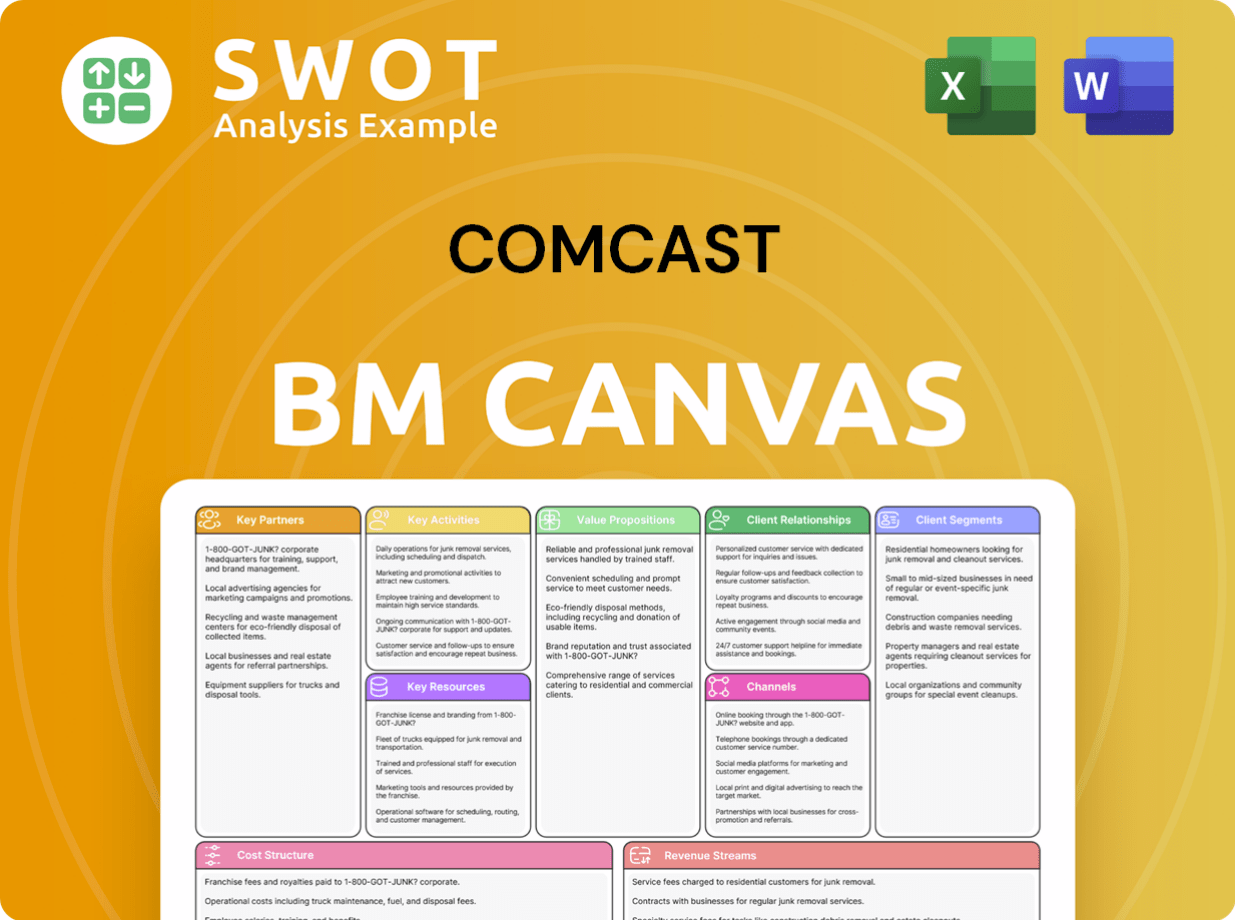
What Are Comcast’s Most Notable Campaigns?
The company's sales and marketing efforts are pivotal to its sustained growth, especially in the intensely competitive broadband and streaming sectors. The company employs a multifaceted approach, utilizing both broad-reach campaigns and targeted strategies to capture and retain customers. These campaigns are designed to highlight technological advancements, offer competitive bundled services, and swiftly address any service disruptions or public relations challenges, ensuring customer trust and loyalty. A key element of their strategy is to maintain a strong market position and drive revenue through effective marketing initiatives.
Comcast's marketing strategy incorporates a blend of traditional and digital channels, ensuring a wide reach and effective engagement with its target audience. The company's approach involves significant investments in advertising, particularly during prime-time television and major sporting events, to maximize visibility and brand recognition. Digital marketing, including social media engagement and targeted online advertising, is also a central component, allowing for precise targeting and personalized messaging. These strategies are crucial for attracting new customers and retaining existing ones, especially in a market where consumers have numerous options for internet and entertainment services. The company's ability to adapt and innovate in its marketing campaigns is critical for maintaining its competitive edge.
Comcast's sales strategy is designed to convert marketing leads into paying customers and to encourage existing customers to upgrade or add services. This strategy involves a combination of direct sales efforts, such as in-store promotions and door-to-door sales, and indirect channels, like partnerships with retailers and online sales platforms. The company's sales teams are trained to understand customer needs and offer tailored solutions, emphasizing the value and benefits of its services. Sales performance is closely monitored, and strategies are adjusted based on market trends and customer feedback. Moreover, the company focuses on customer relationship management to enhance the sales process and improve customer satisfaction. For a detailed look at the competitive landscape, check out the Competitors Landscape of Comcast.
Launched in 2023 and continuing into 2024, this campaign highlights the speed, reliability, and future-readiness of its network. The creative concept focuses on its fiber-rich network's capabilities, using dynamic imagery and testimonials. The primary channels include TV advertising, digital advertising, and social media to reinforce its technological leadership.
This campaign, such as 'Xfinity Internet + Mobile,' aims to drive cross-selling and customer retention. It features competitive pricing and incentives for combining services, emphasizing convenience and cost savings. Targeted digital ads, email marketing, and in-store promotions are the main channels used.
Deployed to address service disruptions or public relations challenges, these campaigns focus on transparent communication and swift action. The goal is to restore trust and demonstrate the company's commitment to customer satisfaction. These are often reactive but crucial for maintaining reputation.
Collaborations with streaming services and content providers are common to boost visibility and credibility. These partnerships often involve offering exclusive content or integrated platforms. This strategy enhances the value proposition and attracts a broader audience.
The company's sales performance is closely monitored using several key performance indicators (KPIs). These KPIs help assess the effectiveness of sales and marketing strategies and identify areas for improvement. Analyzing these metrics provides insights into customer acquisition costs, customer lifetime value, and overall revenue generation.
- Subscriber Growth: Track new customer additions for broadband, video, and mobile services.
- Churn Rate: Monitor the percentage of customers canceling services.
- Average Revenue Per User (ARPU): Measure the average revenue generated per customer.
- Customer Acquisition Cost (CAC): Calculate the cost of acquiring a new customer.
- Customer Lifetime Value (CLTV): Estimate the total revenue a customer will generate over their relationship with the company.
Comcast Porter's Five Forces Analysis
- Covers All 5 Competitive Forces in Detail
- Structured for Consultants, Students, and Founders
- 100% Editable in Microsoft Word & Excel
- Instant Digital Download – Use Immediately
- Compatible with Mac & PC – Fully Unlocked
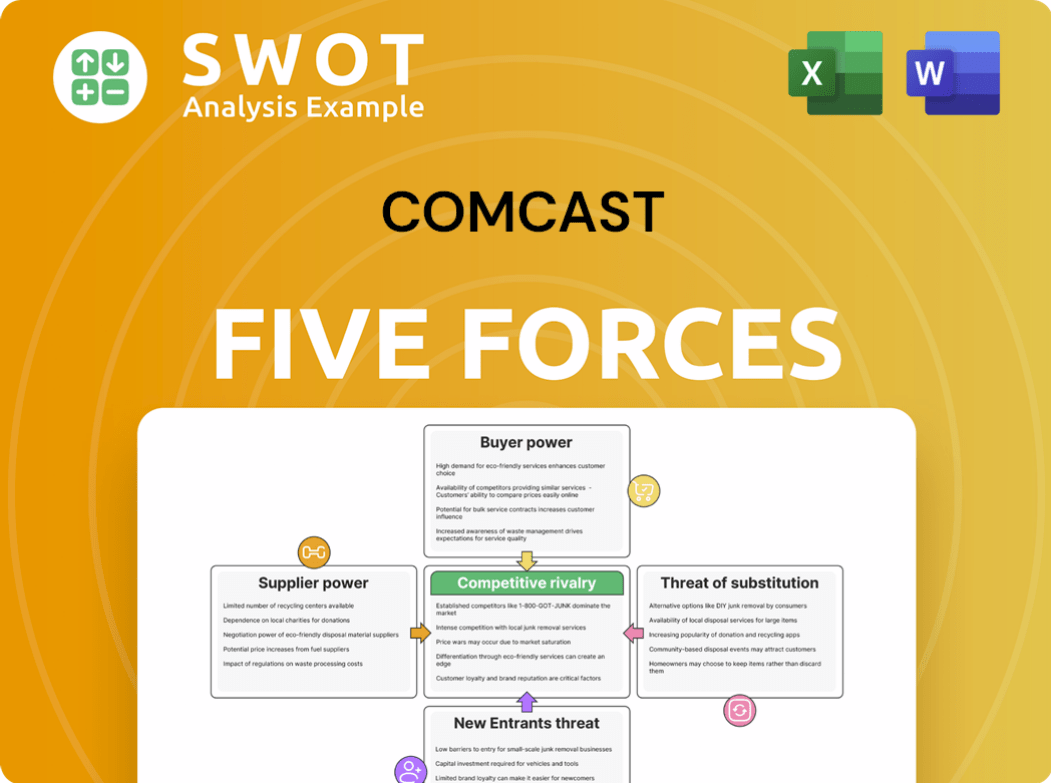
Related Blogs
- What are Mission Vision & Core Values of Comcast Company?
- What is Competitive Landscape of Comcast Company?
- What is Growth Strategy and Future Prospects of Comcast Company?
- How Does Comcast Company Work?
- What is Brief History of Comcast Company?
- Who Owns Comcast Company?
- What is Customer Demographics and Target Market of Comcast Company?
Disclaimer
All information, articles, and product details provided on this website are for general informational and educational purposes only. We do not claim any ownership over, nor do we intend to infringe upon, any trademarks, copyrights, logos, brand names, or other intellectual property mentioned or depicted on this site. Such intellectual property remains the property of its respective owners, and any references here are made solely for identification or informational purposes, without implying any affiliation, endorsement, or partnership.
We make no representations or warranties, express or implied, regarding the accuracy, completeness, or suitability of any content or products presented. Nothing on this website should be construed as legal, tax, investment, financial, medical, or other professional advice. In addition, no part of this site—including articles or product references—constitutes a solicitation, recommendation, endorsement, advertisement, or offer to buy or sell any securities, franchises, or other financial instruments, particularly in jurisdictions where such activity would be unlawful.
All content is of a general nature and may not address the specific circumstances of any individual or entity. It is not a substitute for professional advice or services. Any actions you take based on the information provided here are strictly at your own risk. You accept full responsibility for any decisions or outcomes arising from your use of this website and agree to release us from any liability in connection with your use of, or reliance upon, the content or products found herein.